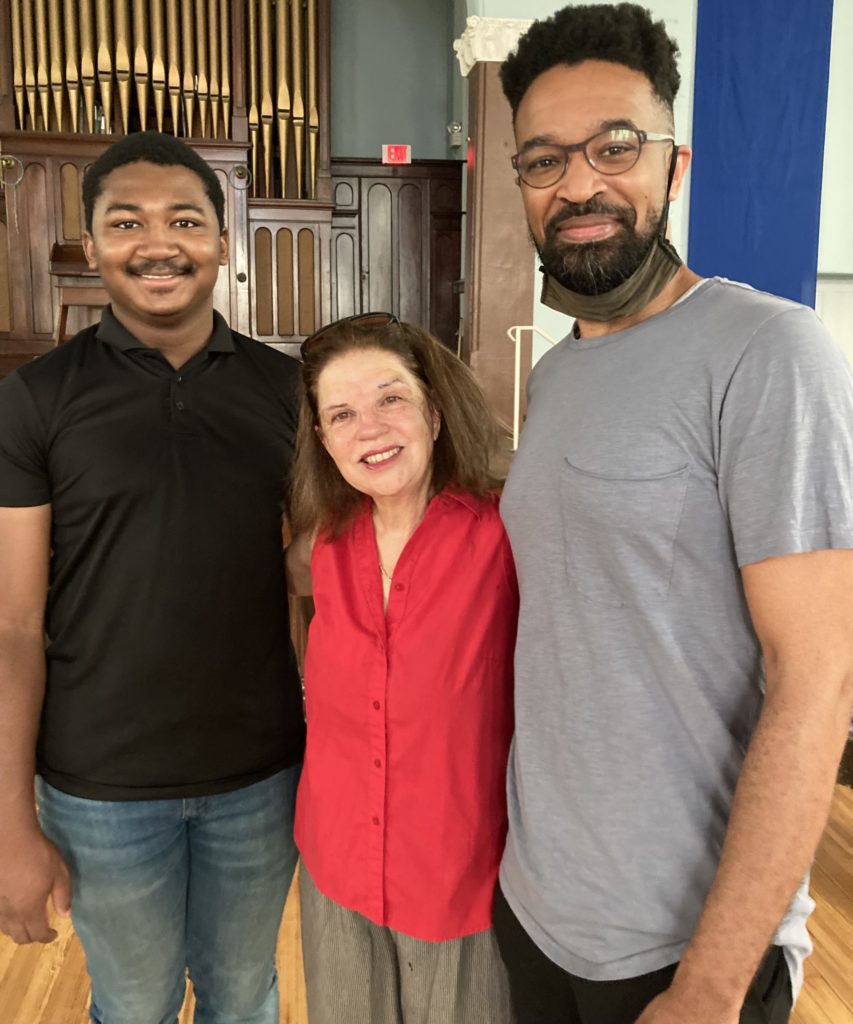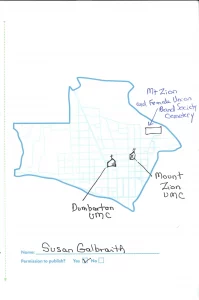Mapping Georgetown: Reclaiming Sacred Grounds of African American History
By • October 18, 2021 One Comment 1804

Mysterious and sacred, cemeteries hold dear the souls of the dead but are often legendary beyond our fathoming. In Washington, D.C., our fraught social and racial histories are often lost or entangled in our burial grounds.
At Mt. Zion and Female Union Band Society Cemeteries in Rock Creek Park — along the Underground Railroad route in the days of American slavery before the Civil War — a camouflaged brick building was used for storing bodies in winter when the ground was too frozen to dig a grave.
Nearby lies Oak Hill Cemetery. Perhaps because I live between P St. and Q Streets NW in this Herring Hill area of Georgetown, I can see in my mind’s eye, Abraham Lincoln, in the dark of night, riding his horse up an unpaved Pennsylvania Ave, turning onto what we know as M St., and then up into Georgetown, to Oak Hill Cemetery, where he was known to “visit” with his son Willy interred there.
From Susan Galbraith, artistic director of the Alliance for New Music-Theatre, our Mapping Georgetown project received this lovely and enlightening description of her local roots and the history of Mt. Zion and Female Band Society and how the historic Black church and cemeteries there might be better understood and more carefully preserved today.
Our sincere thank you to Susan for helping us understand and appreciate our local history with this heartwarming story!
We know that place can call us in the same way people can provide us a “calling.” What does it mean when it all happens at once?
My family has lived across Buffalo Bridge from Georgetown off and on since I was a teenager. In the last seven years, my partner and I have been drawn to the little-known park, hidden by buildings and a “corrected” Q Street at 27th. There lies a cemetery, which has been abandoned and neglected for decades but reclaimed little by little, that holds the key to an important history of this city that most of us never knew. It is the history of Black Georgetown – a history that begins to fill in the holes of collective memory of not just our city but of our country.
It is the history of two cemeteries – Mt. Zion and the Female Union Band Society. There lies also the story of a church – The Old Methodist Church – which was formed 250 years ago next year – a church that split – White and Black parishioners – to become the Dumbarton United Methodist Church and the Mount Zion Methodist Church, and the latter was in turn split and split again.
So, why were these cemeteries never included on a map of Georgetown?
The “Mother Church” and what then took place in the 1800s has much to teach us about the complex history of urban slavery, where congregants lived, worked, worshipped together, and were buried together – and not just Black and White but enslaved and free – for many years. This sacred ground avoids any monolithic narrative and is unsettling but fascinating for that reason.
It offers up more questions than answers. As the cemetery moved in the mid-1800s from being a three-quarters White population to a predominantly Black cemetery, why did some White people choose to remain buried there while others disinterred and “moved” next door when Oak Hill Cemetery opened? Were Blacks buying and therefore owning slaves, a way to keep families together and was this the universal motivation? How is it possible that in Washington by 1843 more than two-thirds of the Black population were free? How did a Black man vote in a national election down the street from the cemetery in Georgetown’s Rose Park before Emancipation? Who was Charles Turner, known as “the Black Mayor of Georgetown?” How was the Benevolent Society of the Female Union Bank able to buy property when at the time no women, White or Black, were able to by law? How did these women, if indeed they did, organize, coordinate and facilitate many enslaved to freedom through the Underground Railroad right there in the middle of Georgetown?
Early summer of 2021, I was stopped one day by a woman with a sparkling way of engaging and at the same time a formidable presence who wanted to help answer my questions and fueled even more questions. Who were these people laid to rest at the cemeteries? And what do their stories have to teach us today about Georgetown’s history?
Lisa Fager, executive director of Mount Zion and Female Union Band Society Memorial Parks, learned of my work with Alliance for New Music-Theatre, whose work combined community engagement and the development of original works across the spectrum of music-theatre. What could I do to support her work?
A work of music-theatre began to form in our minds. Could we debut the piece on April 16, D.C.’s Emancipation Day, 2022?
Soon, we had buy-in from the two Methodist Churches, Dumbarton United Methodist and Mount Zion who have seriously and steadily been doing the work of recognition and reconstruction for some time: the congregants are models for us and will be part of the process. We found a composer for the project and learned, as fortune serves us, that Ronald Walton was the accompanist for Mount Zion’s Sunday services. We learned that there existed music scores from the period in Mount Zion’s archives, possible original music to be retrieved. We found our writer in Jarrod Lee, a member of Alliance for New Music-Theater and a gifted baritone opera singer.
As Lisa Fager has kept telling the story, more and more people have wanted to be involved. This could be an original take on Mapping Georgetown in new ways with collaboration and partnerships at its core.
Susan Galbraith
Artistic Director, Alliance for New Music-Theatre

On the Mapping Georgetown card, Susan Galbraith has plotted out the locations of the Mt. Zion United Methodist Church, the Dumbarton Methodist Church and the Mt. Zion Female Union Band Society Cemetery.
This Mapping Georgetown story can be viewed in full at https://mappinggeorgetown.com/2021/10/04/mt-zion-and-female-union-band-society-cemeteries/.
We invite you to add your story to our Mapping Georgetown collection. Blank templates can be printed from the home page of www.mappinggeorgetown.com, picked up from The Georgetown Public Library or by contacting mappinggeorgetown@gmail.com.
To learn more about the Mapping Georgetown project see https://georgetowner.com/articles/2021/07/19/marilyn-butlers-vision-for-mapping-georgetown/. Marilyn Butler can be reached at marilyn.butler@gmail.com


Marilyn Butler’s Mapping Georgetown appears to be the”glue” to uniting neighborhood civic projects like the above cemetery project!